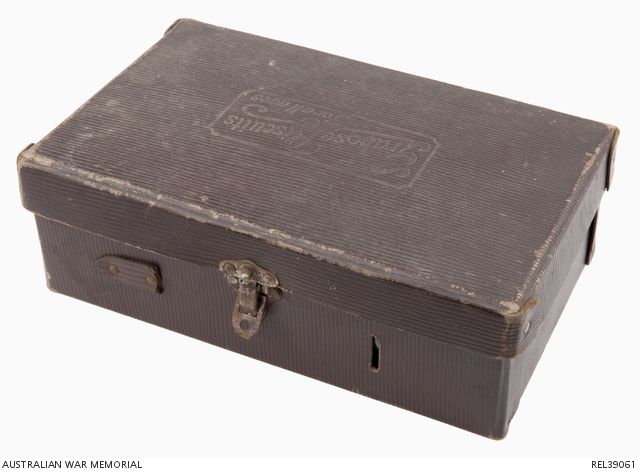| Places | |
|---|---|
| Accession Number | REL39061 |
| Collection type | Heraldry |
| Object type | Personal Equipment |
| Physical description | Cardboard, Leather, White metal |
| Maker |
Unknown |
| Place made | United States of America |
| Date made | c 1939-1945 |
| Conflict |
Second World War, 1939-1945 |
Improvised first aid kit : Lieutenant A E Englert, Royal Australian Naval Reserve


Small brown cardboard suitcase with a dark brown textured finish on the outer surfaces. Impressed on the lid is 'Granose Biscuits for all ages' . The lid is secured by a metal clasp at the front and at the back by two small leather tabs held in place with small metal rivets. The corners of the case are secured with the same type of rivets. The handle, once attached beneath the front clasp, is no longer present.
Inside the case is an improvised First Aid kit comprising tubes of 'Tannemol Jelly' for scalds and sunburn, made by H Faulding & Co (Australia), and Tannafax Jelly for burns and scalds made by Burroughs Wellcome & Co (Australia); a packet of 27 Aspro tablets, made by Nicholas Pty Ltd, Melbourne; a cake of soap; two rolls of cotton wool; a crepe bandage secured by a large safety pin; two packets of 3 inch wide Johnson & Johnson (Sydney) Red Chain gauze bandage; three packets of 1 inch wide Johnson & Johnson (Sydney) Red Chain gauze bandage; a packet of 2 inch gauze bandage made by convenience Inc, Greenville, South Carolina, USA; two rolls of 2 inch wide gauze bandage made in Australia by W.O.W. Bandage; and four loose rolls of gauze bandage.
Allan Keith 'Keith' Englert was born on 21 April 1918 at Maclean, NSW. He enlisted with the Citizen Military Forces on the 7 August 1940 and was allocated the service number N81794. However, his army service papers indicate he did not march on to base until 1 October 1941, the day he was discharged. Five days later he joined the Royal Australian Navy (RAN) as an ordinary seaman and was appointed to the Royal Australian Naval Reserve (RANR). He undertook six months basic training at HMAS Cerberus in Victoria and was then posted to HMAS Hobart from April to July 1942. He was serving in her when she took part in the Battle of the Coral Sea in May 1942.
After his brief time in the Hobart, Englert returned to Cerberus for two months basic officer training. He then moved to HMAS Rushcutter in Sydney on 8 September 1942 for an anti-submarine course on Fairmiles and was appointed an acting sub-lieutenant. Englert spent a short time at HMAS Penguin, also in Sydney, in February 1943 before having his rank confirmed. He then posted to Fairmile Motor Launch (ML) 818 when it was commissioned in late March 1943.
Much of Englert's time with ML 818 was spent on anti-submarine patrols along the north coast of New Guinea and the islands of the South-West Pacific using Madang as a base. The launch also ferried army personnel between ports in the area. ML 818 collided with US Navy Patrol Torpedo boat 329 at Mios Woendi on 12 August 1944 coming off the worst with a large hole in her starboard side aft end. After the damage was repaired Englert and his crew were tipped off by a local native to the presence of four Japanese troops in the vicinity of Korim River. On the 24 August together with the crews from MLs 426 and 816 they captured the Japanese, who were armed with grenades and in poor health.
Englert was promoted to lieutenant on the 9 September 1944. ML 818 arrived in Sydney in late October for a refit and Englert left the ship to join Harbour Defence Motor Launch (HDML) 1342. He was given the command of the vessel on 13 November 1944. All of HDML 1342's duties were spent in the New Guinea area. After the declaration of peace in August 1945, Englert and his crew took part in the evacuation of Japanese soldiers from Wewak. They also traded with the islanders of Karkar, swapping bully beef, rice and tobacco for fruit. A snake was inadvertently brought aboard the vessel at this time which caused some consternation among the crew. Englert off loaded the fruit at the Army hospital at Wewak where it was gratefully received.
HDML 1342 also sunk a sea mine north of Yue Island. After the forward heavy gun failed to detonate the mine, the order was given to close the range and use its .303 calibre guns. These were mounted on the bridge and were thought to provide a better trajectory. When the mine was hit and began to emit a blue-grey smoke, the order was given to move away at full speed. The crew reacted with urgency to this order, however the mine sunk without exploding. After his service in New Guinea Englert was discharged from the navy on 21 March 1946.